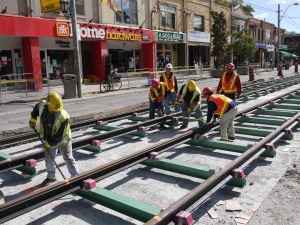Installing the new streetcar tracks and overhead cables required very specialized skills, so the work was done by the appropriate TTC crews (trackwork and cablework).
They were fortunate in that they did not have to dig out the old material. They did have to work in coordination with  the pavement contractor. The trackwork required three concrete pourings: the base on which the steel cross-ties were laid, the middle level that anchored those cross-ties, and then the street-level layer. The last was poured after the final rail alignments, of course.
the pavement contractor. The trackwork required three concrete pourings: the base on which the steel cross-ties were laid, the middle level that anchored those cross-ties, and then the street-level layer. The last was poured after the final rail alignments, of course.
Cross-ties are formed with the rail lockings in place, so the ties had to be placed by plan, of course, but adjusted the actual street conditions. You may see one slide where the tracks barely miss a sewer access. The tracks also had to be placed to account for the new bumpout transit stops. And, of course, each pair of rails had to be kept a specified distance from the other, hence, the photo showing the crew moving a pair of rails in front of Home Hardware.
The Howard Park/Roncesvalles intersection required midnight shift work because the “diamond” (the actual four-way rail intersection was one piece, as were each of the switch tracks (“points”). Each adjoining rail had to be cut and welded in place.
Each rail joint was welded, unlike the old system in which rail sections were bolted. no more “clunk-clunk” when the wheels cross rail joints.
 The cables, too, required careful placement, as the actual bare wire must be centered between its pair of rails. The wires also have to move along with the tension from the car, but within limits. Four trucks of crews worked each night, leapfrogging while maintaining proper tension and alignment.
The cables, too, required careful placement, as the actual bare wire must be centered between its pair of rails. The wires also have to move along with the tension from the car, but within limits. Four trucks of crews worked each night, leapfrogging while maintaining proper tension and alignment.
The slide show of track work and the slide show of cable work include some fairly dramatic night pictures as well as some of the cool machines they used for the heavy work.
